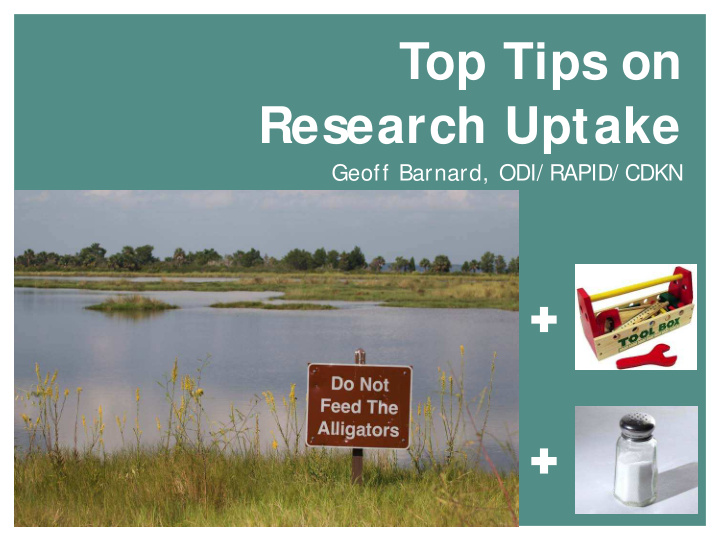



Top Tips on Research Uptake Geoff Barnard, ODI/ RAPID/ CDKN ✚ ✚
Things to weigh up • Where can you have • You can’t do everything greatest impact? • You have a given budget • What skills can you • You only have certain skills realistically develop? & capacities right now • Where to bring in specialist • This will all take time help? • Everyone is very busy • Who’s responsible? One thing for sure: w ithout an agreed strategy, and regularly updated plans, it’ll get forgotten
Different models for organising research uptake efforts Coordinator A A A B D Hub Hub C B C B C Centralised Hub and spoke Shared • Each has advantages • Depends on resources available, and capacity of each partner • Vital to decide early on
What’s in the tool box There are a lot of resources available (see RAPID hand- out “Useful Resources on Research Uptake”) As a starting point: • Use the RAPID framework questions to help you understand the context • Use the AIIM matrix to help with your stakeholder analysis I f you w ant to get into m ore detail: • Try the Rapid Outcome Mapping Approach (ROMA) to create a systematic analysis
No.1 Get to know your context really well The policy soup
Policy processes are complex... Cabinet Donors Policy Formulation Parliament Agenda Setting Decision Making Civil Society Ministries Monitoring and Policy Evaluation Implementation Private And you’re just Sector one amongst all these players
Useful tools • Theory of change • RAPID framework External Influences Socio-economic and cultural The political context – political and influences, economic structures and processes, donor policies etc culture, institutional pressures, incremental vs radical change etc. The evidence – credibility, the The links between policy degree it challenges received and research communities – wisdom, research approaches and networks, relationships, power, methodology, simplicity of the competing discourses, trust, message, how it is packaged etc knowledge etc.
No.2 Narrow down your primary audience
A common mistake • Being vague • Trying to reach everyone and as a result • Failing to reach anyone
Identifying audiences Alignm ent, I nterest and High I nfluence Matrix ( AI I M) Develop Learn in General level of enthusiasm to 1. Identify all alignment partnership address topic stakeholders 2. Map them onto the Develop Challenge alignment / interest awareness existing beliefs and matrix enthusiasm 3. Identify who has Low power Interest in Low High specific topic 4. Identify who you Where have you got can influence leverage?
No.3 Really get to know them You need to walk in their shoes
How to win friends and influence people • Start early • Invite them onto your steering group • Listen and learn about their agendas/ challenges • Roundtable events • Field visits • Secondments, exchanges, advisory panels • Games
No.4 Distil your message, then distil it again
Attention spans are very small This is hard Come on, work, I think get to the I’ll go and Why am I point chase that reading cat this?
No.5 Target your communication
Draw up a targeting matrix Trainin Journal Policy Media Face- Social Audience Video g Article Brief article to-face m edia m odule The Minister Minister’s advisors You can’t do all of these well. Donor agency Which ones do you want Field staff to concentrate on? Academic peers etc.
No. 6 Use others to amplify your message
Types of knowledge brokers Journalists Netw orks Other w ebsites • International • Topic related • Blogging sites • National • Professional • Portals • Local • Communities • Climate of interest Knowledge • Community Brokers Group
No. 7 Go to where the action is Don’t expect people to always come to you
A “Being There*” strategy • Attend and speak up at key meetings • Publish on other websites • Follow and comment in social media • Go to other people’s parties (and don’t hide in the corner!) * Coined by Nick Scott, ODI
No.8 Identify windows of opportunity
Grabbing those chances good planning + A much better good antennae chance you’ll + = have some good networks impact + opportunism + a clear message + a bit of luck
In Summary: 1. Get to 5. Target your know your communications context 6. Use others to 2. Narrow amplify your down your message audience 3. Really get 7. Go to where to know them the action is 4. Distil your 8. Identify windows message of opportunity
Be strategic, but be prepared to adapt
Time for a reality check Questions • How much of this is new territory? • Can you draw on your organisation’s help? • Have you planned for this in the budget? • How to get started?
For more information contact: Geoff Barnard, consultant CDKN: www.cdkn.org RAPID: www.odi.org.uk/ programmes/ rapid Note: this presentation draws on personal views and experience and does not necessarily reflect those of CDKN, ODI or any of their respective sponsors.
Recommend
More recommend